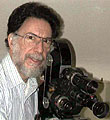|
|
This topic comprises 2 pages: 1 2
|
|
Author
|
Topic: Paso aereo (sorry, I donīt know the english transltn.)
|
|
|
John Pytlak
Film God

Posts: 9987
From: Rochester, NY 14650-1922
Registered: Jan 2000
|
 posted 09-05-2002 09:20 PM
posted 09-05-2002 09:20 PM





I've heard of the very poor practice of breaking down a plattered feature by running it onto 2000 foot shipping reels as it comes off the projector. No leaders put back on the print, lots of opportunity for cinches and dirt, and film often cut mid-scene. Film Done WRONG, big time.  ------------------
John P. Pytlak, Senior Technical Specialist
Worldwide Technical Services, Entertainment Imaging
Research Labs, Building 69, Room 7525A
Rochester, New York, 14650-1922 USA
Tel: +1 585 477 5325 Cell: +1 585 781 4036 Fax: +1 585 722 7243
e-mail: john.pytlak@kodak.com
Web site: http://www.kodak.com/go/motion
| IP: Logged
|
|
|
|
|
|
Gerard S. Cohen
Jedi Master Film Handler

Posts: 975
From: Forest Hills, NY, USA
Registered: Sep 2001
|
 posted 09-06-2002 02:26 PM
posted 09-06-2002 02:26 PM




paseo aereo=[print breakdown] on the flyI think you refer to the practice John P. described, called in English breaking down a print "on the fly."
I never attempted it myself, but some mentioned it as a mark of their dexterity, since it meant cutting the film at the splice,removing the full reel from the lower magazine, replacing it with the next empty shipping reel, and fixing the cut end to the reel hub, twirling the reel to take up slack, and locking the reel spindle, all while the film is traveling 90 feet per minute! I believe this risky procedure was reserved for emergencies, since the projectionists I worked with were all adequately compensated for breakdown time by contract. Where two or more projectors were in working condition (three per booth were standard in the 42nd St. theatres) there wouldn't be the need for
"on the fly." But if forced to finish the last show on the only workable machine remaining, this method might have some emergency value.
| IP: Logged
|
|
|
|
|
|
|
|
|
|
Manny Knowles
"What are these things and WHY are they BLUE???"

Posts: 4247
From: Bloomington, IN, USA
Registered: Feb 2002
|
 posted 09-07-2002 09:17 AM
posted 09-07-2002 09:17 AM




From what you are describing, paso aereo sounds like it could be an idiomatic expression that is similar to the English idiom "a high-wire act."Like a circus performer on a tightrope, the procedure you describe is probably very interesting to watch because it is full of suspense. Similarly, it is so unnatural that few (or none) of us would ever have a practical need to do it. Also, it is so fraught with obvious danger that nobody in their right mind should ever want to actually do it himself.
| IP: Logged
|
|
Steve Kraus
Film God

Posts: 4094
From: Chicago, IL, USA
Registered: May 2000
|
 posted 09-07-2002 09:45 AM
posted 09-07-2002 09:45 AM



I'm a little unclear on how the clown performing this stunt handles the joining on the fly. Take-up I can understand because the film can dump on the floor indefinitely but where does the buffer come from that is to give the brief respite needed to make the joins? Someone mentioned feeding from an arm mounted on an adjacent table but that alone doesn't do it. So I suppose that as the end approaches the clown-ectionist manually pulls a bunch of film off the reel so there is a pile on the floor to feed the machine while cutting the leader and making the splice. Twin arms mounted in line on that table would probably help.This could be done properly if one had elevators like they have on processing machines, both before and after the projector. An elevator is something like a roller cabinet with film going up and down many times over many rollers except that the lower rollers are on a frame that can move up or down. On the feed side the end while the film is clamped temporariliy to make the join the film still feeds into the machine and the elevator rises as it supplies the film. When the new roll is attached and the clamp released the elevator drops as film feeds into it faster than the machine is taking it. On the takeup side just the opposite: The elevator is empty as film feeds through it to a take up core but when the end of a unit is reached and this must be changed the elevator drops as it fills with film until the new roll is started. BTW, I am still waiting to see video of a bi-filar loop in action.
| IP: Logged
|
|
John Pytlak
Film God

Posts: 9987
From: Rochester, NY 14650-1922
Registered: Jan 2000
|
 posted 09-07-2002 09:48 AM
posted 09-07-2002 09:48 AM





Manny: Thanks. Using another idiom, I think you "hit the nail on the head".Confession: When I worked at the Grandview Drive-In in the late 1960's, at least once per season, Carl and I challenged each other to remove the intermittent and reinstall it (including retiming the shutter) between reels DURING a show! Usually had to be done in less than 15 minutes, including threading the next reel and trimming the carbon lamp. Easily done on the Century Model C projector, but is was a "high wire act" that could have been embarrassing if we were too slow, or made a mistake. (In three seasons, we never missed the next changeover or came back on with travel ghost). ------------------
John P. Pytlak, Senior Technical Specialist
Worldwide Technical Services, Entertainment Imaging
Research Labs, Building 69, Room 7525A
Rochester, New York, 14650-1922 USA
Tel: +1 585 477 5325 Cell: +1 585 781 4036 Fax: +1 585 722 7243
e-mail: john.pytlak@kodak.com
Web site: http://www.kodak.com/go/motion
| IP: Logged
|
|
|
|
John Walsh
Film God

Posts: 2490
From: Connecticut, USA, Earth, Milky Way
Registered: Oct 1999
|
 posted 09-07-2002 10:49 AM
posted 09-07-2002 10:49 AM




Many years ago, two new managers took over where I used to work.I think they were trying to impress me with how good the staff was at their old theater by explaining how they had spliced the last reel onto to a feature that was running an interlock. Apparently, only the first "three reels" can arrived in time for the show; they put in on the platter and started. The last reels came 30 min later; they put it together on a 6000ft reel and placed the reel on the make-up table. They then pulled off about 100 feet of tail film from the running platter, (letting it drag all over on the floor, I'm sure) spliced it onto the reel and let it run. The thing I found interesting was: They honestly thought they did the right thing. In fact, they were quite proud of it. To them, the goal was to not stop a show (risking refunds and customer dis-satifaction.) They could not understand why I was not impressed, and thought I was not a "team-player" etc.
| IP: Logged
|
|
|
|
|
|
All times are Central (GMT -6:00)
|
This topic comprises 2 pages: 1 2
|
Powered by Infopop Corporation
UBB.classicTM
6.3.1.2
The Film-Tech Forums are designed for various members related to the cinema industry to express their opinions, viewpoints and testimonials on various products, services and events based upon speculation, personal knowledge and factual information through use, therefore all views represented here allow no liability upon the publishers of this web site and the owners of said views assume no liability for any ill will resulting from these postings. The posts made here are for educational as well as entertainment purposes and as such anyone viewing this portion of the website must accept these views as statements of the author of that opinion
and agrees to release the authors from any and all liability.
|

 Home
Home
 Products
Products
 Store
Store
 Forum
Forum
 Warehouse
Warehouse
 Contact Us
Contact Us




 Printer-friendly view of this topic
Printer-friendly view of this topic











 A test of dexterity for the projectionist, but a print full of dirt and scratches for the audience. And I suspect they cut a few frames from the reel every time they show it.
A test of dexterity for the projectionist, but a print full of dirt and scratches for the audience. And I suspect they cut a few frames from the reel every time they show it. 








